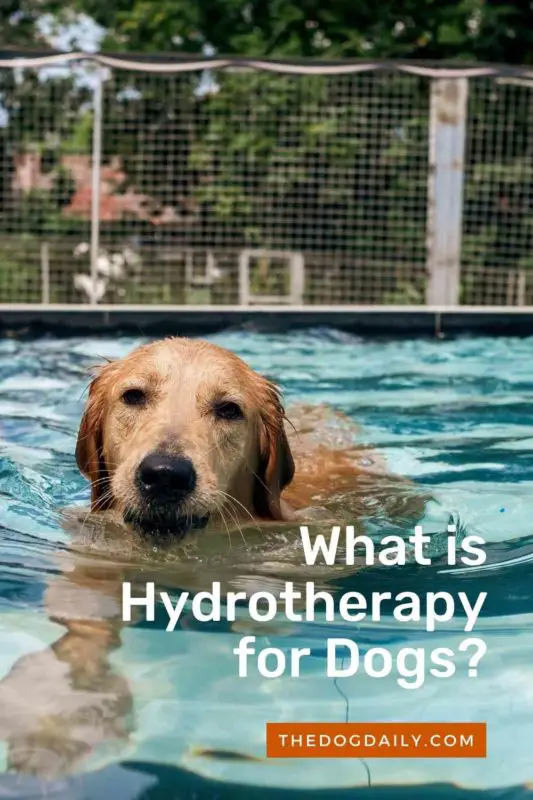What Is Hydrotherapy for Dogs?
Emma, a Golden Retriever, clearly loves her hydrotherapy sessions at Doggie Paddle in Portland, Oregon. The two-and-a-half-year-old swims for 45 minutes with the water jets blasted on high. And then there’s two-year-old Labrador Retriever Seamus. “He won’t get out of the pool unless he’s retrieved four rubber chickens. Not two or three, but always four,” says Julie Thomas, who owns the canine therapeutic swimming and exercise business.
While the sessions might seem like fun and games to Emma and Seamus, hydrotherapy provides essential physical therapy to dogs, especially those who have difficulty engaging in regular outdoor activities. “It can be comparable to human physical therapy, only for dogs,” Thomas says.
Hydrotherapy usually involves either a small pool with a treadmill or, in the case of Doggie Paddle, a larger pool with adjustable swim jets that provide resistance. With the latter on high, just a five-minute swim can be equivalent to a five-mile run. Most facilities keep the temperature comfortable and warm. Chlorine can irritate dogs’ skin, coat, and eyes, so look for a pool that offers some other, gentler form of filtration and sanitizing.
Dogs either walk right in or, if they need a bit of help, are carried into the pool. “I had a Great Dane once who just lay in my arms and did not move a muscle,” shares Thomas. “I simply got behind him and moved his legs as though he were riding a bicycle.” This movement got his circulation going, helping to relax his muscles and improve his joint function.
Which Dogs Benefit Most From Hydrotherapy?
Thomas says that at least seven types of dogs get the most out of hydrotherapy, including:
- Dogs who are recovering from surgery. This includes canines that have undergone everything from amputations to hip surgery.
- Overweight dogs. For dogs with packed-on pounds, swimming provides “a safe, low-impact way to burn calories.”
- Older dogs. When arthritis kicks in and energy levels slow down, hydrotherapy can still provide your senior dog with regular exercise.
- Overactive dogs. Some healthy dogs just have incredible energy to burn. They can work it off safely in the pool without driving your family nuts.
- Sporting dogs. Dogs that compete in sports, such as agility, gain conditioning from pool time.
- Dogs — both literally and figuratively — on their last legs. Thomas often sees dogs right before they are euthanized, allowing them to naturally relax and provide owners with one final meaningful, shared moment with their beloved pet.
- Dogs up for adoption. Doggie Paddle is located very near the Oregon Humane Society’s Westside adoption center.
How Hydrotherapy Helps Homeless Dogs
Go into any animal shelter, and you’re bound to see dogs looking less than fabulous. They are often stressed, older, out of shape, and perhaps feeling unloved. That’s where Thomas’s work comes into play. For the past two years, she’s been donating swim sessions to homeless dogs and improving their chances for adoption.
“They not only get in shape physically, but they also become more socialized and used to handling,” she explains. Karl Willard, an animal care technician at the OHS, believes the shelter is the first in the country to offer this form of enrichment.
Splashy Fun for Dog Owners Too
At some pools, such as the one at Doggie Paddle, owners can go in along with the dog(s). This can lead to an excellent workout for all and what amounts to a mini-refreshing pool party.
“Sometimes friends will do this together,” Thomas says. “I have a few clients who bring all six of their bearded collies.” She has yet another client who brings her four dogs — along with her 5-year-old son.
The Human-Dog Connection
Before starting her hydrotherapy business, Thomas earned a doctorate in adult education and gerontology. She is also certified to do hydrotherapy and massage for dogs. All have come in handy. “In terms of gerontology, the basic concepts concerning many physical issues, emotional concerns, and more carry over to dogs,” she says.
Many dogs enjoy a soothing rubdown as they enter or exit the Doggie Paddle pool via a ramp. “Dogs frequently bark like crazy in their owner’s cars because they can’t wait to get here,” she says. After hydrotherapy, they display another mood, she concludes. “One dog is so relaxed that he drifts into blissful slumber after each session.”
Article written by Author: Jennifer Viegas

